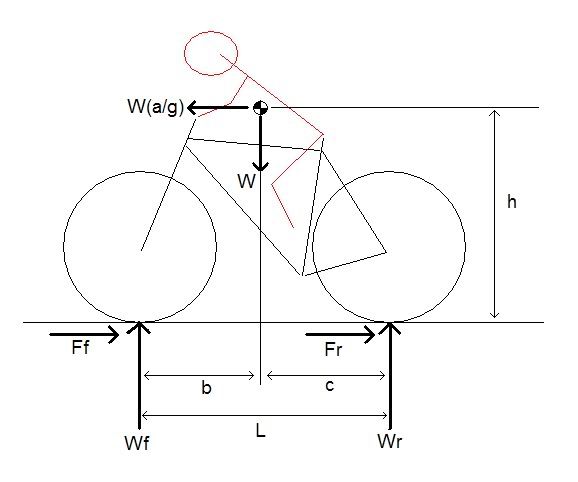A Preface:
This is NOT intended to claim anyone is wrong for choosing to ride with or without brakes.
^^ Read that again, I mean it.
I wrote this to give everyone an idea of the dynamics of what exactly happens when you have to decelerate your bike. If you are curious, read on.
A quick description of how a bike brakes on a level road, with as little “engineer speak” as possible. A couple assumptions: 1)The bike is “traction limited” (the rider can lock the wheel, through brakes or skidding) and 2)Aero drag is neglected, as it is relatively small compared to braking force and it would be the same for the brake or brakeless rider.
Here is a diagram of the relevant forces acting on a bike during braking.

W is the combined weight of the rider and bike acting at the center of mass, positioned approximately halfway along the wheelbase of the bike, at height ‘h’.
Wf and Wr are the weights at each wheel, before braking. During braking, weight will shift to the front wheel and we will call these new weights Wfb and Wrb.
Ff and Fr are the friction forces between the tires and road that are actually slowing the bike.
The friction force at the wheel can be approximated by multiplying a friction coefficient, ‘u’, by the weight on the wheel. So during braking,
(eqn1) Ff=u*Wfb
at the front wheel. In other words, more weight on the wheel means more friction force.
I’ll spare you the DiAllembert and summation of moments stuff. The weight on the front wheel when the rider brakes is described as:
(eqn2) Wfb = Wf + W*(a/g)*(h/L)
And similarly the rear wheel:
(eqn3) Wrb = Wr - W*(a/g)*(h/L)
The easy way to describe this equation is the weight on the wheel during braking equals the ‘original’ weight plus or minus (in respect to front or rear wheel) the weight transferred from the effect of braking.
In the case of front wheel only braking, the summation of forces equation is:
Ff = W(a/g)
Substitute eqn1:
u*Wfb = W(a/g)
Substitute eqn2:
u*( Wf + W*(a/g)*(h/L)) = W(a/g)
Solve this equation for (a/g) and the answer is your deceleration in g’s:
(a/g) = (u*(Wf/W)) / (1-u*(h/L))
For the case of rear wheel braking only, the deceleration is:
(a/g) = (u*(Wr/W)) / (1+u*(h/L))
Make up some weights and dimensions:
W = 200 lbs (rider and bike)
Wf = Wr = 100 lbs (using the assumption the center of mass is at the center of the wheelbase)
L = 40 inches
h = 40 inches
u = 0.7
These values show the front brake rider could decelerate at 1.17 g’s and the brakeless rider could only manage 0.206 g’s. Quite a difference.
The brake-equipped bike can’t really decelerate quite that fast. Substitute this deceleration, a/g = 1.17, into eqn3 and you will see that the weight on the rear tire is negative – huh? In other words, the rear wheel has come off the ground and the rider has (possibly) gone over the bars.
Yes, there are TONS of variables I didn’t include in this explanation: condition of the brakes, the skidder shifting his weight, etc. Still, it should give you an idea of just why a brake-equipped bike can stop quicker than its brakeless equivalent. If a brakeless rider tells you he can stop faster than a bike with brakes, recite this explanation to him, and ask him why Mr. Newton’s laws don’t happen to apply to him.

I am open to any comments, questions, corrections, flames, smart-ass comments that you all have for me. Again, please believe me when I say I did not write this to upset anyone. I truly believe everyone out there should ride the bike that makes them happy, brakes or not. I’m just trying to give a little something back (in the form of engineering-nerd knowledge) to a forum I really enjoy reading every day.
Mac